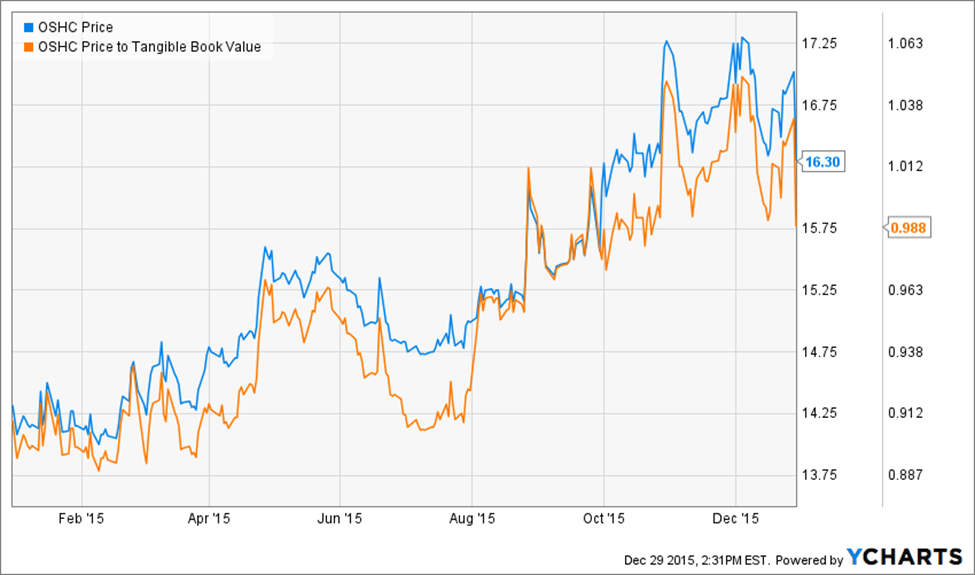Interest Rates Rise – Who Benefits?
The Federal Reserve finally decided to raise the base interest rate by 25 bps. The first thing to happen after the announcement was that banks raised their lending rates.
Within the banking universe, the banks that have the highest probability of utilizing higher interest rates to increase shareholder value are the small community banks. These banks are generally straightforward lending institutions that borrow short (deposits), and lend long (mortgages). They do not share the risks or financial complexity of the larger banks.
Ocean Shore Holding Company (Nasdaq: OSHC) is a good example. This is a community bank on the New Jersey shore that completed a second step mutual conversion about 5 years ago. They borrow short and lend long, all in the local community that they understand very well. They simply grow their deposit base and local loan book. In the low rate environment that has been in place for the last 5 years, they have delivered a total annualized return to shareholders of 13.3%. They are currently selling for 98% of book value.

The SEC requires all companies to publish a section in their 10K's and 10Q's called "Quantitative and Qualitative Disclosures about Market Risk". In this section the company assesses the impact of the most significant market forces that in their judgment affect the financial results of their company. For banks this should include the potential changes in interest rates. This is a good starting place to understand the impact of rising rates on OSHC. The relevant section from the 10Q for 3rd quarter for OSHC is shown below:
MARKET RISK MANAGEMENT
Net Interest Income Simulation Analysis
We analyze our interest rate sensitivity position to manage the risk associated with interest rate movements through the use of interest income simulation. The matching of assets and liabilities may be analyzed by examining the extent to which such assets and liabilities are "interest sensitive." An asset or liability is said to be interest rate sensitive within a specific time period if it will mature or reprice within that time period.
Simulation analysis is only an estimate of our interest rate risk exposure at a particular point in time. We continually review the potential effect changes in interest rates could have on the repayment of rate sensitive assets and funding requirements of rate sensitive liabilities.
The following table reflects changes in estimated net interest income only for the Company:
|
At June 30, 2015 Percentage Change in Estimated Net Interest Income Over |
||||||||
|
12 Months |
24 Months |
|||||||
|
200 basis point increase in rates |
7.21 |
% |
10.53 |
% |
||||
|
100 basis point decrease in rates |
(0.94 |
) |
(3.12 |
) |
||||
N/M - not measurable
The 200 and 100 basis point change in rates in the above table is assumed to occur evenly over the following 12 and 24-month periods. Based on the scenario above, net interest income would be positively affected (within our internal guidelines) in the 12-month and 24-month periods if rates rose by 200 basis points and negatively affected (within our internal guidelines) in the 12-month and 24-month periods if rates decreased by 100 basis points.
If interest rates rise by 200 bps over the next year, OSHC management expects net interest income to increase by 7.21%. If you project the rate of increase in rates by the Fed to be half of the historic rate increase, we can expect a rise in rates of 150 bps. This translates to a net income increase of 150/200 * 7.21% = 5.4% over that 12 month period. This margin increase is additive to the returns that they have been showing for the last 5 years. In addition, OSHC continues to be a likely acquisition candidate at a price that will probably be >1.2 X book value. This would represent a 33% increase from today's price level, around $22 per share.
Caveats
Net Interest Income Simulation Analysis (NIISA) does not include the fact that as rates move up real estate values are likely to decline and credit quality problems could increase, resulting in the need for an increased provision for loan losses. This analysis assumes that all rates, long and short-term move up equally. It is reasonably likely that short-term rates could move up but long term rates may not move up as fast, resulting in a flattening yield curve. That would cause the NIISA to be inaccurate.
The models used to calculate what the increased cost of deposits might be in a rising rate environment are dated. They do not factor in the advances in technology that allow depositors to easily move money. That leads one to be skeptical of NIISA. These models are flawed. Deposit costs will move up faster than the models predict, leading to less of a benefit than these models show.
Conclusion
Over the next 12-24 months, OSHC should be able to benefit from a mildly rising interest rate environment and the bank is a prime roll up candidate in the sector. There is a 30% upside to the stock within the next two years with limited downside.
OSHC has been a careful underwriter. Their depositor base is better than average, which will help ameliorate any problems with the interest rate. Their loan losses will be minimal unless rates rise by over 2%.
Disclosure: more



